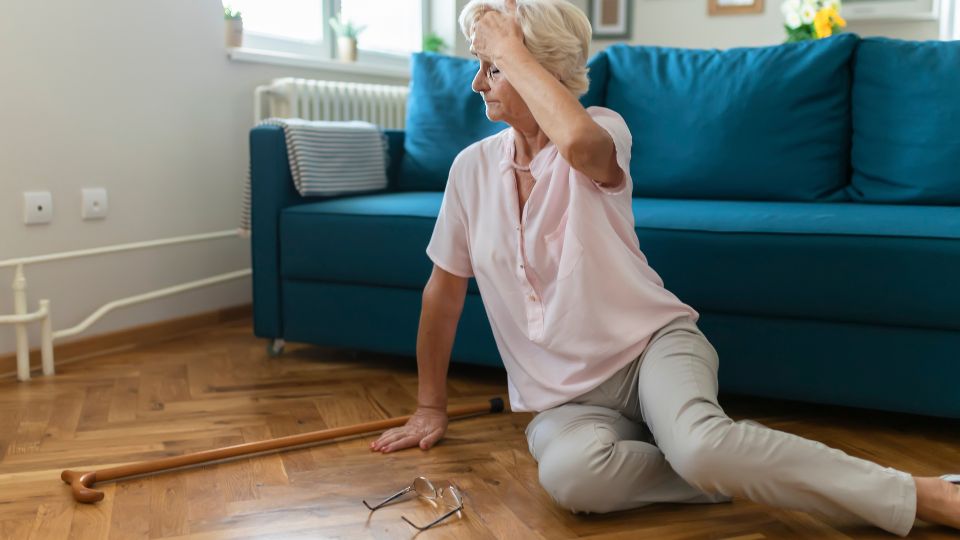Strokes can instil fear due to their potentially life-threatening nature, but they are manageable with proper measures. To reduce the risk of stroke or offer assistance to someone affected, it’s vital to understand the different stroke types, their symptoms, and available treatments.
The three primary stroke types are:
- Ischemic
- Hemorrhagic
- Transient ischemic attack (TIA)
These strokes can result in symptoms such as slurred speech, blindness, or paralysis. However, before delving into these details, let’s first understand what a stroke entails.
Understanding A Stroke
A stroke is a critical medical situation when the brain’s blood supply is abruptly disrupted. Strokes contribute substantially to the global toll of fatalities and disabilities.
Strokes give rise to noteworthy consequences, encompassing:
- Restricted movement or paralysis, often affecting one side of the body.
- A sense of distress or discomfort.
- Impairments in speech, comprehension, and swallowing.
- Fluctuating moods, feelings of despair, and anxiety.
- Challenges in performing daily essential tasks like dressing and bathing.
- Memory lapses and hindrances in cognitive processes, including decision-making.
These factors illuminate the multifaceted impact of strokes on individuals’ well-being and functioning.
Unveiling Stroke Origins
The causes of a stroke can vary depending on the specific stroke type experienced by a patient. There exist three primary stroke categories, which are as follows:
- Haemorrhagic Stroke: This type occurs when an artery within the brain ruptures or develops a leakage. The resultant blood flow from the affected artery raises intracranial pressure, leading to brain enlargement and the detriment of brain cells and tissues.
- Ischemic Stroke: In an ischemic stroke, blood vessels supplying the brain encounter constriction or blockage. These blockages often stem from blood clots or a significant reduction in blood supply. Plaque fragments can also contribute to the obstruction.
- Transient Ischemic Attack (TIA): A fleeting disruption in blood flow to the brain characterises TIA, colloquially called a “mini-stroke.” While symptoms mirror those of a full-fledged stroke, they are usually transient and dissipate within minutes or hours as blood flow is reinstated.
These overarching stroke categories can be further divided into subtypes:
- Thrombotic
- Subarachnoid,
- Embolic, and
- Intracerebral
Stroke onset is sudden and can prove severe. Recognising and responding promptly to the rapid onset of stroke symptoms is crucial, as timely intervention can help minimise the resulting damage.
It’s essential to remain vigilant about recognising the signs of a fast-occurring stroke and taking immediate action to seek medical attention, as this proactive approach significantly contributes to mitigating the impact of the stroke.

What Does FAST In Stroke Mean?
In 1998, a collaborative effort between stroke physicians, ambulance personnel, and an emergency department physician in the United Kingdom led to the creation of the FAST acronym as an integral component of an ambulance staff training program.
Research endeavours involving FAST have yielded diverse levels of diagnostic precision when employed by emergency medical technicians and paramedics. The positive predictive values derived from these studies range between 64% and 77%.
FAST, an abbreviation infused with mnemonic resonance, underscores the virtues of rapidity and decision-making in stroke assessment.
F – Facial Drooping: Characterised by the sagging or immobilisation of a facial segment, often noticeable on one side. A crooked or asymmetric smile serves as a distinct indicator.
A – Arm Weakness: Denotes the inability to fully elevate one’s arm or the incapacity to grip objects or exert pressure, such as a handshake.
S – Speech Impairment: Encompasses struggles in articulating or comprehending speech, encompassing slurred enunciation or repetition of simple phrases, such as “I am ok.”
T – Time: In instances where any of the symptoms above manifest, swift action is imperative to seek medical attention (dial 000). Vigilantly monitoring the passage of time aids in precisely pinpointing when symptom onset occurred.
Familiarity with the FAST stroke symptoms can save invaluable time, particularly in scenarios necessitating immediate intervention to safeguard life. Keeping the “FAST” acronym at the forefront of awareness is pivotal for promptly recognising the precursors of a stroke.
What Are The Signs Of Stroke?
A stroke’s symptoms and cues can vary depending upon the specific region of the brain affected and the extent of cerebral damage incurred.
Nonetheless, they frequently encompass the ensuing manifestations:
- Rapid onset of arm, facial, or leg weakness or numbness, predominantly on one side of the body.
- Sudden confusion, challenges in communication, or abrupt difficulty in comprehending others.
- Unexpected vision impairments in one or both eyes.
- Abrupt emergence of gait disturbances, dizziness, loss of equilibrium, or lack of coordination.
- A sudden, intense headache with no discernible cause.
Gaining proficiency in first aid from an accredited provider equips you with the readiness to manage emergencies, including strokes effectively. Acquiring knowledge about stroke indicators, symptoms, and appropriate responses can significantly impact the outcome of an individual undergoing a stroke episode.

What Are The Warning Indications Of Impending Stroke?
Pre-stroke symptoms can manifest abruptly and display considerable variation from person to person. The ensuing are some of the indicative warnings of an impending stroke:
- Diminished sensation or weakness on a particular side of the body, most frequently affecting the visage, arm, or leg.
- Impairment in comprehending or articulating thoughts.
- Visual impairments like blurriness or complete vision loss in one or both eyes.
- Disorientation, compromised balance or coordination, or a fusion of both.
- Impaired mobility or ambulation.
- Episodes of fainting or seizures.
- Intense, unexplained headaches.
Less frequent pre-stroke symptoms might encompass:
- Sudden onset of vomiting and nausea unrelated to viral causes.
- Transient periods of unconsciousness or altered mental state, including fainting, confusion, seizures, or entering a state of coma.
A pre-stroke occurrence can serve as a vital forewarning of an impending stroke. Timely intervention can forestall the progression to a full-blown stroke. Consequently, seeking immediate medical attention is imperative upon experiencing these warning signs.
Is Headache A Possible Pre-Stroke Symptom?
Headaches can occasionally manifest as a prelude to a stroke, though they are not frequently observed symptoms. Nevertheless, it’s crucial to recognise that not all headaches preceding a stroke are intense. Certain individuals might encounter mild to moderate headaches before a stroke, while others might not undergo any headaches at all. Additionally, it’s noteworthy that not every stroke is associated with headaches.
What Are The Symptoms Of Anterior Cerebral Artery Stroke?
A stroke takes place when the flow of blood supply to the brain is cut off at the Anterior Cerebral Artery (ACA), one of the primary arteries in the brain. A clot in the bloodstream or intracranial bleeding can both cause this disturbance.
The symptoms associated with an ACA stroke may encompass the following:
- Facial numbness, weakness, or paralysis
- Vision problems
- Impaired cognitive function
- Difficulty in walking
- Speech difficulties
- Changes in sensory perception
- Headache and vomiting
Importantly, it’s worth noting that the symptoms of an ACA stroke can vary widely based on factors such as the specific location and severity of the stroke, the individual’s age, and overall health status.
What Are The Signs And Symptoms Of A Middle Cerebral Artery Stroke?
The middle cerebral artery (MCA) is a vital blood channel that supplies blood to the brain. A stroke affecting the MCA occurs when there is a disruption in the brain’s blood supply. This can result from either an ischemic stroke or a hemorrhagic stroke.
The manifestation of symptoms in a middle cerebral artery stroke can be influenced by various factors such as an individual’s overall health, age, precise location, and the severity of the stroke.
Symptoms commonly associated with an MCA stroke encompass:
- Impaired function or altered sensation
- Slurred speech
- Blurred vision
- Problems with balance
- Episodes of dizziness or vertigo
- Headache
- Confusion or difficulty with cognitive processes
It’s important to recognise that the symptoms of a middle cerebral artery stroke can differ based on individual circumstances and the specifics of the stroke.
What Are The Symptoms Of Brainstem Stroke?
The brainstem, a vital connector between higher-level brain functions and bodily activities, is pivotal in regulating essential life processes like breathing and heart rate. This region, nestled deep within the brain and extending to the skull-spine junction, is responsible for various vital functions.
Brainstem strokes stem from blockages in arteries such as the basilar artery, posterior inferior cerebellar artery, or vertebral artery on one side of the neck. The causes behind brainstem strokes mirror those triggering strokes in other cerebral regions.
Brainstem strokes yield a diverse array of symptoms, some of which are outlined below:
- Weakness or altered sensation may manifest on the side of the body opposite the affected brainstem.
- Impaired eye muscle control due to a brainstem stroke can lead to double vision.
- As the brainstem governs balance perception, dizziness and vertigo frequently occur in the wake of such strokes.
- Facial and mouth muscles may exhibit asymmetrical strength, resulting in drooping eyes or sagging lips on one side. This can also lead to difficulties in swallowing, slurred speech, or a skewing of the tongue.
- Weakness in the shoulders may present as an inability to shrug both shoulders symmetrically.
A brainstem stroke can induce a complex interplay of symptoms, with each individual potentially experiencing a distinct combination.

Can A Stroke Lead To Epilepsy And Seizures?
Epilepsy encompasses a range of neurological conditions characterised by recurring seizures. These seizures come in various forms and types, contributing to the diversity within epilepsy.
In the immediate aftermath of a stroke, an isolated seizure may occur. However, experiencing a single seizure doesn’t necessarily equate to having epilepsy, and the occurrence of multiple seizures isn’t a definitive indicator either. The likelihood of developing epilepsy may be heightened following specific stroke types, such as those causing bleeding or strokes of greater severity.
Managing post-stroke epilepsy often involves using anti-convulsant medication, which is generally effective in its treatment.
Can A Stroke Precipitate Skin Allergies?
The occurrence of allergic skin reactions due to a stroke is infrequent. Skin allergies typically stem from the immune system’s response to foreign substances like chemicals, allergens, or medications.
Allergic reactions often manifest as redness, itching, and skin swelling.
In exceptionally rare cases, a stroke might lead to skin changes, such as variations in colour or temperature and sores or ulcers. These alterations can arise from disrupted blood flow to the skin or other stroke-related complications.
What Are The Ways To Identifying Stroke Symptoms?
Several methods can help in recognising the potential signs of a stroke, including:
- FAST Test: This acronym stands for Face, Arms, Speech, and Time tests. It offers a straightforward way to assess potential stroke symptoms quickly.
- Cincinnati Prehospital Stroke Scale: This test, conducted by first responders and medical experts, aids in assessing stroke likelihood. It encompasses a series of evaluations to gauge consciousness, comprehension, speech, and limb mobility.
- NIH Stroke Scale: Medical professionals utilise this scale to gauge the stroke’s severity. It involves a range of questions and assessments to evaluate an individual’s cognitive functions, physical abilities, and speech.
It’s essential to understand that the outcomes of these tests do not provide a definitive stroke diagnosis and should not replace seeking medical help. If you suspect someone might be experiencing a stroke, prompt medical attention is crucial.
What Are The Stroke Treatment Options?
The approach to treating strokes is tailored to the specific type of stroke and the extent of brain damage incurred. The most commonly diagnosed stroke subtypes are ischemic and hemorrhagic strokes.
Several options exist for treating ischemic strokes:
- Thrombectomy: A medical procedure involving the extraction of a blood clot from a cerebral artery using a catheter. This thin tube is threaded through an artery in the leg and guided to the clot, restoring blood flow.
- Medications: Certain drugs, such as tissue plasminogen activator (tPA), can dissolve blood clots and reestablish normal blood circulation. Swift administration within hours of stroke onset is crucial for effective results.
- Rehabilitation: Many patients require post-stroke rehabilitation to regain lost function. Rehabilitation may involve occupational therapy, speech therapy, and physical therapy.
Hemorrhagic strokes, caused by ruptured arteries within the brain leading to internal bleeding, present distinct treatment possibilities:
- Medication: Certain medications, often employed for managing high blood pressure, can help control bleeding and mitigate the risk of further hemorrhaging.
- Surgical Intervention: In some instances, surgical procedures may be necessary to repair damaged blood vessels, drain accumulated blood within the brain, or extract blood clots.
Like ischemic strokes, individuals recovering from hemorrhagic strokes often require rehabilitation to optimise their functional recovery post-event.
It’s important to recognise that stroke treatment is multifaceted and should be administered under the guidance of qualified medical professionals. Each case necessitates a customised approach based on the specific stroke type, its severity, and the patient’s overall condition.

How To Identify 4 Subtle Signs Of Silent Stroke?
Some individuals experience strokes without any overt indications, giving rise to what are known as silent strokes. These elusive events transpire without noticeable symptoms or recollection, yet they leave behind irreversible damage to the brain.
Here are four inconspicuous symptoms that could indicate a silent stroke:
- Disturbances in Balance and Spatial Perception: A silent stroke may disrupt the brain’s equilibrium and spatial orientation centres, leading to sensations of dizziness or vertigo.
- Swallowing Difficulties: Stroke survivors might encounter difficulty swallowing or perceive a sensation of food getting stuck in their throats.
- Behavioural Alterations: Post-stroke, shifts in behaviour and temperament could emerge, unsettling the brain’s equilibrium. Abrupt onset of anger, mood variations, or feelings of sadness are potential manifestations.
- Cognitive Impairments: The impact of a silent stroke on the brain’s information-processing capabilities might result in memory lapses, reduced concentration, and compromised decision-making abilities.
It’s crucial to recognise that these subtle symptoms of silent stroke might not be immediately apparent. Diagnosis often requires a brain scan to unveil the extent of damage incurred.
Reducing Stroke Risk: 7 Key Prevention Approaches
Taking measures to prevent a stroke is entirely possible, with these strategies playing a pivotal role:
- Blood Pressure Management: Keeping blood pressure in check substantially curbs stroke likelihood. Lifestyle changes and prescribed medications contribute, encompassing exercise, a balanced diet, and refraining from smoking.
- Active Lifestyle: Regular physical activity emerges as a potent shield against stroke, correlating with blood pressure moderation and enhanced cholesterol profiles.
- Diabetes Control: Effective diabetes management, combining diet, exercise, and medication, proves pivotal in mitigating stroke risk for individuals grappling with diabetes.
- Diet: Stroke prevention can be greatly improved by eating a diet packed with whole grain foods, vegetables, and fruits and low in sodium, saturated fat, and trans fat.
- Smoking Cessation: Abandoning smoking not only diminishes stroke risk but also curtails the chances of various other grave health issues.
- Atrial Fibrillation Management: Addressing irregular heart rhythms, such as atrial fibrillation, emerges as a proactive measure to minimise stroke susceptibility.
- Alcohol Moderation: Excessive alcohol consumption elevates stroke risk, underscoring the importance of moderation.
Adhering to these guidelines empowers you to reduce your stroke risk substantially, consequently fostering overall well-being.
Preventing And Managing Seizures Following A Stroke: Effective Strategies
Mitigating the occurrence of seizures and effectively managing them after a stroke necessitates a multi-faceted approach:
- Adhering to Medication: If your doctor prescribes medications to prevent or control post-stroke seizures, strict adherence to the prescribed regimen is crucial.
- Trigger Recognition and Avoidance: Recognising potential triggers for seizures, such as sleep deprivation, stress, or alcohol consumption, is vital. Striving to avoid these triggers whenever possible is key.
- Healthy Lifestyle Choices: Opting for a nutritious diet, abstaining from tobacco, engaging in regular exercise, and practicing moderation in alcohol consumption can significantly lower the risk of post-stroke seizures.
- Prompt Medical Attention: If you encounter a seizure or unusual symptoms after a stroke, seeking immediate medical care is paramount for proper evaluation and intervention.
- Medical Alert Accessories: For individuals prone to seizures following a stroke, donning a medical alert necklace or bracelet that outlines your medical history and prescribed medications can offer valuable assistance.
- Ongoing Medical Care: Regular visits to your healthcare provider and adhering to their recommended treatment plan are pivotal in preventing and managing seizures post-stroke.
By embracing these measures, you can proactively minimise the likelihood of seizures after a stroke while effectively managing any that may arise.
What Are The Risk Factors For Stroke In Children?
While less common than in adults, strokes can occur in children. The causes of strokes in children encompass various possibilities:
- Congenital Heart Abnormalities: Children born with heart defects may face an elevated stroke risk due to inadequate oxygenated blood supply to the brain.
- Infections: Certain infections like meningitis or HIV can heighten the likelihood of strokes in children.
- Blood Abnormalities: Conditions like sickle cell anemia or thrombocytopenia can increase stroke risk in children.
- Brain Trauma: Head injuries or other forms of brain trauma may trigger strokes in young individuals.
- Underlying Medical Conditions: Medical conditions such as lupus or sickle cell anemia can also contribute to heightened stroke risk in children.
It’s crucial to promptly seek medical attention if a child is suspected of experiencing a stroke. Paediatric first-aid measures to consider include:
- Immediate Action: Dial emergency services (e.g., 000) without hesitation.
- Airway Check: Ensure unobstructed breathing. Administer CPR if breathing ceases.
- Keep Calm: Maintain a reassuring demeanour to comfort the child while awaiting medical help.
- Minimise Movement: Prevent the child from moving or attempting to walk, which could exacerbate the situation.
- Note Symptom Onset: Document when symptoms began to aid medical staff in diagnosis.
Swift medical intervention is paramount in stroke cases. Timely treatment increases the chances of successful recovery for the child.

Diagnosing Strokes
Diagnosing strokes involves several diagnostic approaches, including:
- Physical Examination: Healthcare professionals assess symptoms like weakness, speech difficulties, and balance problems.
- Blood Tests: Specific enzymes released during brain cell injury are detected through blood tests.
- Imaging Techniques: MRI, CT scans, and angiography create detailed images to determine stroke type and extent of brain damage.
- Electroencephalogram (EEG): Monitoring brain electrical activity aids in identifying stroke-related brain function issues.
- Carotid Ultrasound: This test detects plaque and blood flow issues in neck arteries using sound waves.
- Cerebral Angiography: X-rays guide a catheter to the brain or neck to visualise blood vessels, detecting blockages or flow problems.
- Echocardiography: Ultrasound imaging helps identify heart conditions contributing to strokes.
It’s worth noting that diagnostic tests may vary depending on individual symptoms and risk factors.
Adapting To Life After A Stroke
Survivors of strokes often encounter physical, cognitive, and emotional challenges. However, many individuals can regain normal routines with appropriate medical attention and a support network.
Navigating life post-stroke involves these essential considerations:
- Medication Management: Medication can alleviate symptoms and prevent future strokes for some. Adhering to prescribed medication schedules and addressing queries with healthcare providers is vital.
- Rehabilitation for Recovery: Rehabilitation is crucial for restoring functionality. Stroke survivors can benefit from therapies to enhance mobility, strength, and other capabilities.
- Coping with Changes: A stroke’s impact on physical, mental, and emotional well-being necessitates adjustment. Seeking assistance from loved ones and specialists can help adapt to cognitive or physical abilities shifts.
- Pursuing Enjoyment and Purpose: Engaging in meaningful activities is pivotal for emotional well-being. Activities that spark joy contribute to mental and emotional health.
- Addressing Underlying Health Issues: Tackling underlying conditions like high blood pressure, diabetes, or atrial fibrillation is vital. Lifestyle adjustments, improved nutrition, exercise, cessation of tobacco use, and medication adherence play crucial roles.


